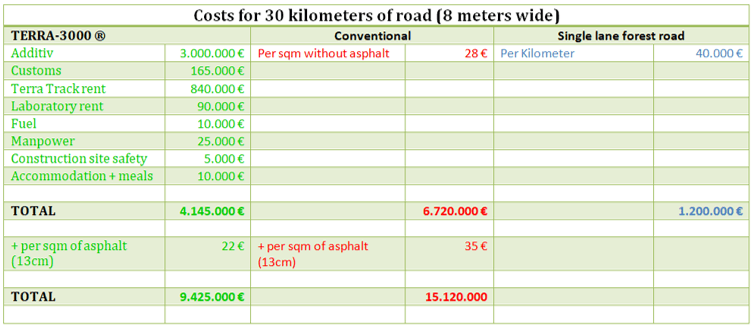A new road construction system
METEMCO SA and our partner TERRA-SYSTEM are pleased to present you with absolutely innovative Nano technology in road constructions. With our system, roads can be built in a simpler, faster and cheaper way. As practical experience shows, the savings, depending on the type of road, are between 30 and 70%!
Product
Our product is TERRA-3000®. It is a liquid organic construction additive that has been designed to greatly improve the strength and water-resistance of in-situ soils used in pavement construction and wide range of other applications such as roads, railways, embankments, hardstands and even brick production.


What is TERRA-3000 ®
TERRA-3000® is an innovative liquid ion exchanger (catalyst) that reduces the surface tension of the water around in-situ soil particles so that the barrier film of water surrounding the particles is dispersed.
TERRA-3000® is not an aggregate or binding material like cement or lime, asphalt or salt. Instead, it need only be present in the soil to provide more compact bedding and almost entirely prevent subsequent swelling.
The process is permanent and irreversible. Almost all soils are suitable. The ideal composition includes fine soil particles of <0.002m of between 15% and 30% by volume.
How TERRA-3000 ® works
Static water, though not moving under the influence of gravity, cannot be regarded as fully motionless. However, the motion caused by osmotic forces or molecular movement is negligible. However, over a long period of time, considerable masses of water may be transported either in liquid or gaseous form (evaporation). Static water contained in the soil can be classified into four categories. This classification is based on the order of magnitude of the force with which they can adhere to soil particles.
1. Chemical water bound within the crystalline structure of the soil
2. Absorbed water which is held on the surfaces of the soil particles
3. Water which is bound by surface tension to the points of contact of the soil particles
4. Capillary water in the pores between soil particles
By lowering the dipole moment of the water molecule, dissociation takes place into a hydroxyl (+) and a hydrogen (-) ion. In turn, the hydroxyl ion transforms into an oxygen and hydrogen ion, and the hydrogen atom of the hydroxyl is transformed into a hydronium ion.
This hydronium ion, in the nascent state, can accept or reject positive or negative charges, according to need. The finest grained soil particles normally have a negative charge. The outer layer of the absorbed water has enough positively charged metal ions such as sodium, calcium, aluminium or magnesium to balance out the negative soil ions.
Consequences:
The absorbed water layer is strongly reduced or even completely broken.
The soil particles tend to agglomerate.
Through the movement of particles towards one another, the surface becomes smaller and can take in less absorbed water, in turn, this means that the swell capacity is reduced. Moreover, these three factors make it easier to compact the soil (or make it all possible).




BACHEMA – SWITZERLAND

MAPAG – AUSTRIA

BUREAU OF REASEARCH AND STANDARTS – PHILIPPINES

OFICINA Y LABORATORIO CARRERA - COLOMBIA
National Approvals


TERRA-3000 ® Bundle


TERRA-3000 ® Process flow

Application

In conventional road construction, the existing earth is removed and transported away. This means a great deal of work, material and time.
Since the existing soil is used with the TERRASYSTEM®, no excavation is required. This work process is completely eliminated. From here, enormous savings also begin.

Anti-freeze layer:
After the excavation, a Anti-freeze layer is installed in conventional road construction.
This consists of gravel. The material for this is not only expensive, but also has to be transported separately.
With the TERRASYSTEM® the existing soil is milled with special machines and there is an admixture and mixing of foreign material and additives, such as: TERRA-3000®. All of this is done in a time-saving process!

Upper unbound base layer:
Now the upper unbound base layer follows. It also consists of special gravel. The material for this must also be delivered again.
This step is not necessary with the TERRASYSTEM®.

Compaction work:
This process is the same for both systems, the roller is used.

Bituminous base layer:
A bitumen base layer is also applied to the TERRASYSTEM®, but only 7 cm thick (50% of the standard value), which is completely sufficient with this system.

Top layer:
With the application of the top layer of asphalt, the road is now finished. In the conventional road construction system, this surface layer is between 8-12 cm.
With the TERRASYSTEM®, the top asphalt surface only needs a thickness of 4-6 cm. So here again time and cost savings.


References
Colombia - Bogotà
Australia - Grain Valley Road
Canada Magog – Eastman


Production
The TERRA-3000 ® additive is currently produced in Austria near Graz.
The current production capacity is 5 containers (5 * 13200 liters) per week.
One container is sufficient for approx. 33 km of road (with a width of 8 meters and a milling depth of 300cm)
The production is ISO certified.
The delivery time for container from depot is 4 weeks.
The Terra Truck is a tailor-made product and the delivery time is 4 weeks from order and deposit.
The mobile analysis van is a bespoke product and the delivery time is 4 weeks from order and deposit.

Calculation

The costs for asphalting depend on the subsoil processing required in advance and the number of layers. The preparation and consolidation of the substrate costs about € 32/sqm, the price for a layer of asphalt is around € 35/sqm. The two-layer asphalt is firmer, smoother and more uniform and costs around € 45/sqm. The price is lower for larger areas.
Conclusions

With TERRASYSTEM® roads can be built in a simpler, faster and cheaper way. As practical experience shows, the savings, depending on the type of road, are between 30 and 70%!

